ROCKET STAGING :HOW AND WHY
When talking about traveling to space, whether deep or orbital space, all vehicles used for Launch serve the same purpose which is: get the load off the earth by overcoming the force of gravity. Every space travel mission starts with the launching of a rocket. You might just be thinking and wondering about payloads that were launched from space shuttle's payload bay; The payload got to space through a shuttle launch which is the same technology that every rocket uses so they all are going to have the same attributes and no matter their size, they all have stages while launching.
All rockets which have ever carried anything to space was a multistage rocket. Payloads has always needed an extra boost of thrust to get over the payload and rockets weight to enable it venture into space. Thrust to overcome the payloads mass is not what is considered alone, The downward force of gravity on the rocket and also the propellants in the rocket that makes up most of its mass are also considered in fact the payload is the smallest part of the mass on a particular launch. This is the reason why staging is very important. Because the fuels or propellants are very heavy, the rocket mass drops as it burns and the structure carrying the propellants becomes dead weight and might hinder the rocket from reaching its destination because they need more fuel to propel and lift. Rocket staging is a very good way of removing of getting rid of these dead weight so as to utilize the energy provided by the remaining propellants to get the payload to its destination.
WAYS OF ROCKET STAGING
1.SERIAL STAGING
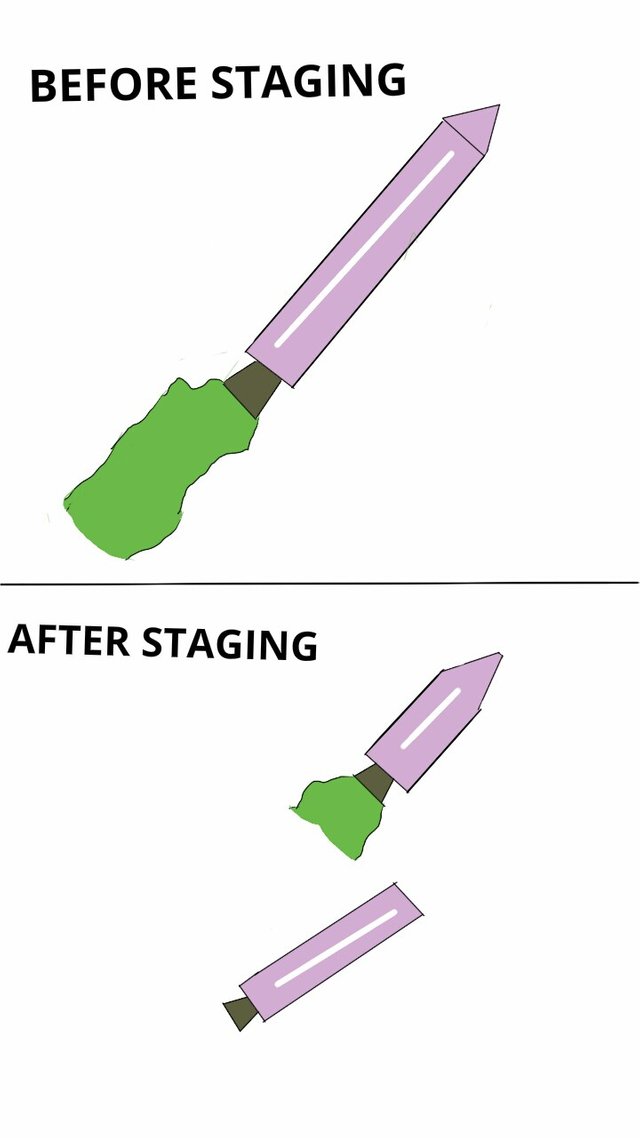
Serial staging is done using rocket stages which are attached one on top of the other. The first stage lights up when the rocket is just being launched and burns the fuels or propellants in it until they are exhausted. when the propellants are finished in the first stage, the stage falls off and the second stage now has the responsibility of propelling the rocket with its own fuel. The second stage is normally capable of taking the rocket to its destination in orbit depending on its mission but a third stage or fourth stage is the ultimate one to send or deliver the payload into space. This all depends on the mission of the rocket though.
The first multi staged rocket's used the serial staging system. Wernher von Braun during the Second World War with the help of his team considered the possibilities of adding more stages to the A-4 to make the much larger A-10 which would be able to travel longer distances. Another example of a serial staged rocket is one of my favorites which is the Saturn V. It is made up of three stages; The S-IC (first stage), S-II (second stage), and finally the S-IVB (third stage). The three stages are separated using explosive bolts. When the propellants in a stage is exhausted and is about to fall off retrorockets which are on the exhausted stage and the ullage motors which are on the stage that is about to get used help separate ans put a distance between the two stages to allow a clean and safe staging.
The Gemini mission which was launched by the Titan II had a slightly different staging technique . It made use of hot staging. when looking at the rocket closely, holes are seen in its body because the second stage was made to come on before the first stage will fall off. The holes were to remove exhaust from the burning second stage.
2.PARALLEL STAGING
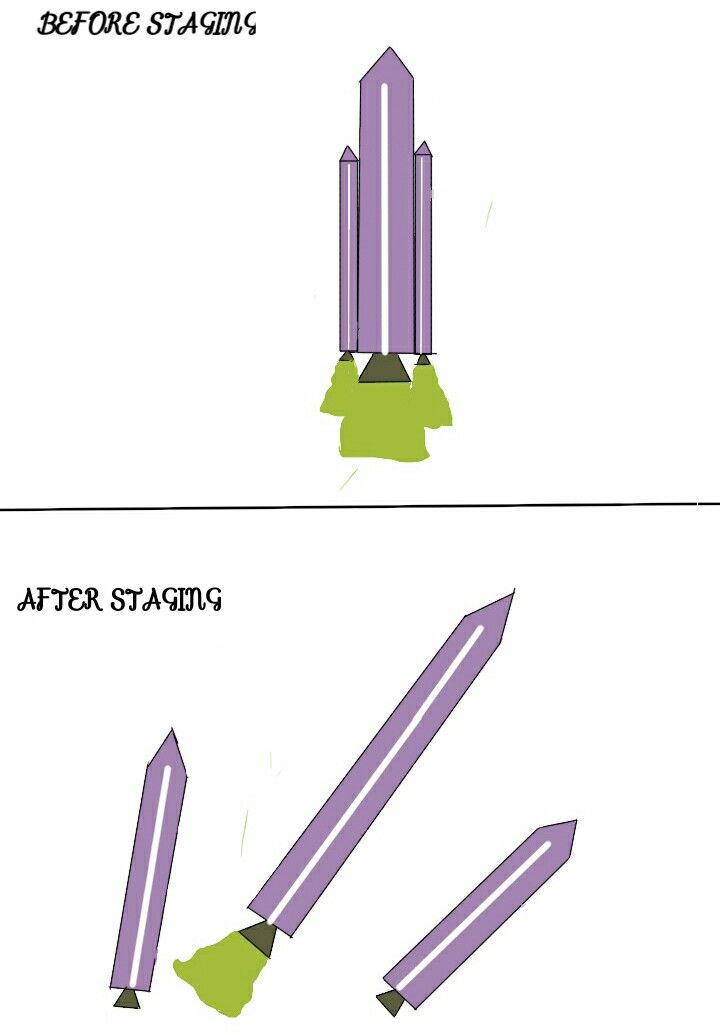
Athother way by which rockets can be staged is the parallel staging method. As we all know, the shuttle space had some boosters by the side of its main tank and not some stages on one another.
Parallel staging technique used booster stages which are strapped to a kind of central sustainer. When the rocket is launched, all the engines ignite and when the propellants of the boosters are spent, they fall off and let the sustainer which is still burning send the payload into space.
About the shuttle, the stages that will fall away are the rocket boosters which have been strapped to sustainer.
Some rocket's however make use of this two staging systems. An example is the Titan III which has a two-stage Titan II which is used as the sustainer, and also two staged rockets as boosters which fall away when their propellants have been used up.
3. STAGE-AND-A-HALF
The next staging technique is pretty uncommon and weird, it is called ''stage and a half''. We all have probably seen it. In 1962, the Atlas D which was the rocket that was used to launch John Glenn and other three astronauts who went the same way he went orbitally used the '' stage and a half system ''.
Rocket's that uses this system has two stages; a main core sustainer stage and a stage that falls off during flight which is the booster. In the Atlas D, the booster is kind of wrapped around the sustainer engine like a skirt. The odd setup of the Atlas D was done because in the mid century,multi staged rockets were being launched but most times, there were cases when the upper stages were not going up on time thereby making the rockets to blow up. The Atlas designers made the odd design to make sure the engines ignited properly. All the engines were turned on in the launch pad. Later in flight, the booster is dropped off as dead weight making it possible for the rocket to propel objects to orbit.
All the methods of rocket staging require the rocket stages to fire or start on time and also for the used up stage to detach cleanly and this creates room for compilations.
WHY ROCKETS ARE STAGED
The major reason why rocket are staged is because the effectiveness or how high a rocket will go is inversely proportional to the mass of the rocket. Staging rockets helps in reducing the rocket mass to ensure greater effectiveness.
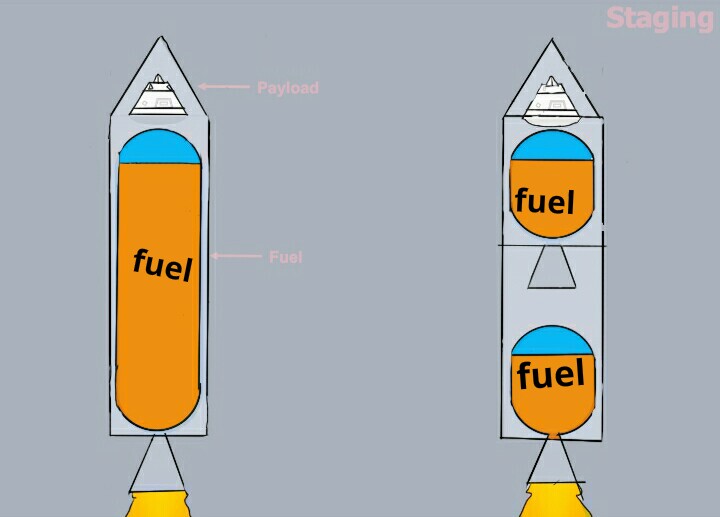
In the picture above there are two types of rocket. The rocket on the right is a multi staged rocket while the rocket one the left has just one stage.
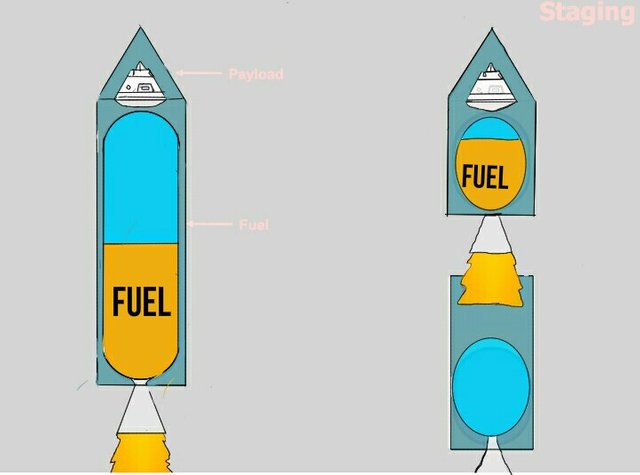
This next picture shows the two rockets at a point in their flight. The one staged rocket has a lot of dead weight to carry along while flying due to the empty fuel spaces and this reduces it's effectiveness. How far it would go can not be compared to the second rocket which is a multi staged rocket. As it flies, It drops the used up tank which would have been dead weight that reduces it's effectiveness.
Also, rockets need a big engine at its first stage to be able to lift it above the earth's surface which has the highest gravitational force on it and also to lift the whole mass of payload and propellants. The engine alone increases the mass of the rocket and stops it from being very effective. A multi staged rocket at a point in flight drops this heavy engine and uses a smaller lighter engine to achieve its full potential.
Here's a video on Rocket Staging.
Please don't forget to leave you comments and please upvote and follow.
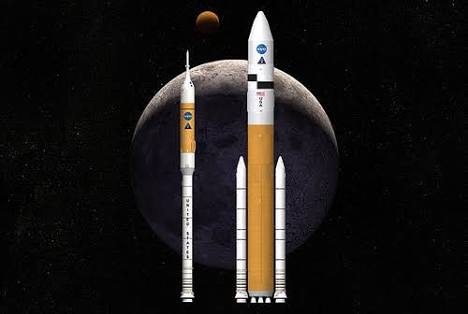.jpg)
.jpg)